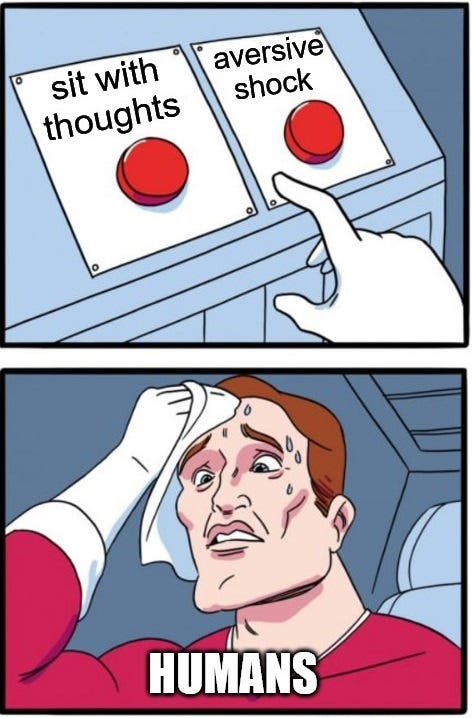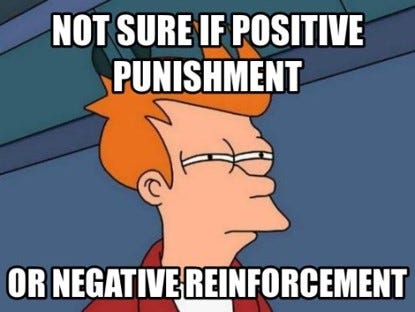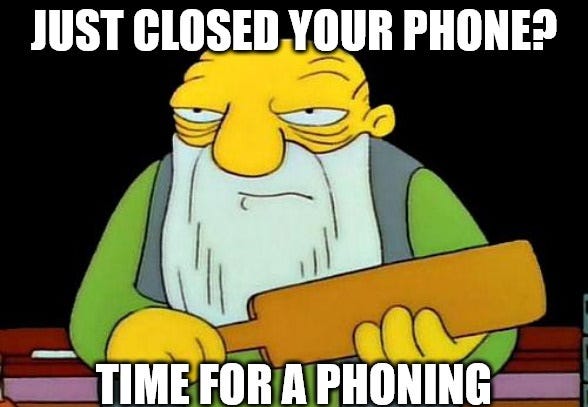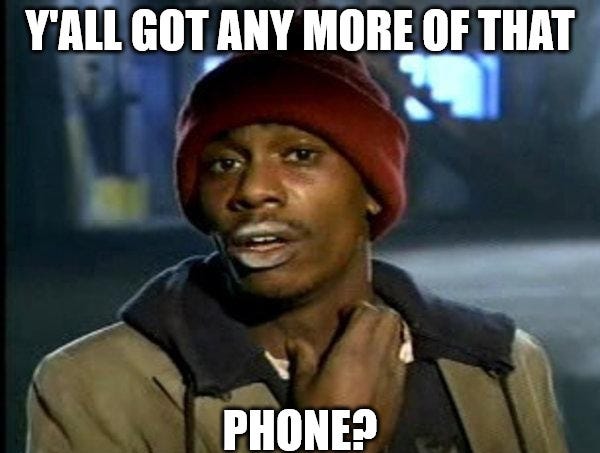Habits: What makes a smartphone so hard to put down?
This is the first of a two-part post on tech habits, algorithms, and enshittification (here is Part II).
When's the last time you simply sat with your thoughts? When's the last time you let yourself be bored without turning to a screen like your phone or TV?
A classic series of experiments in 2014 asked people to sit alone with their thoughts for anywhere from 6 to 15 minutes without access to their phones or anything else (Wilson et al., 2014). The majority reported at least some difficulty concentrating and around half rated the experience as not enjoyable (below midpoint on a 9-point scale). Those trying this at their own home found it even less enjoyable than those doing it in an undecorated laboratory room, perhaps because their own forbidden devices were so close to hand (whereas in the lab version, their phone and other belongings weren't in the room with them). None of that is what made this research famous, though.
The crazy part of the study was a condition where participants in the lab first spent some time rating positive and negative stimuli (happy photos, a mild electric shock) and reported how much money they would pay to experience or avoid those things (if they were given $5 to spend, say). Not surprisingly, most people said they would pay to avoid the shock. But in the second half of the experiment, when again left alone with their thoughts for 15 minutes in a room without their phone or other belongings, a ton of participants chose to shock themselves.
Indeed, among the people who earlier had said they'd pay to avoid the shock experience, now 67% of them (men) or 25% of them (women) found sitting with their thoughts so unpleasant they chose to shock themselves. Many of us really don't like to just sit without external stimulation.

It's no wonder, then, that so many of us are now in the habit of pulling out our phones at the prospect of even a moment unstimulated. Standing in line for coffee? Whip out your phone. Waiting for your partner to pee before leaving the house together? Phone time. Just finished a task on your phone and put it in your pocket? Somehow it ends up back in your hands again a moment later.
How habits form: Positive and negative reinforcement
One way to understand this habit we've all gotten into comes from the field of behavior analysis (aka behaviorism). As B.F. Skinner and decades of researchers after him have demonstrated, many of our habitual behaviors are maintained by reinforcing and punishing contingencies. What does that mean?
A contingency means that our environment (the literal environment, social environment, technical environment, laws of physics, whatever) is set up in such a way that when we do a particular behavior in a given situation, there is a predictable outcome.
Sometimes the outcome is good, which is reinforcing for that behavior (making it more likely to occur in this situation in the future) and sometimes the outcome is bad, which is punishing for that behavior (making it less likely to occur in this situation in the future). So what might be reinforcing the behavior of almost-unconsciously pulling out your phone so often and in so many situations?
One way to think of it is in terms of positive reinforcement which is a contingency where doing the behavior predictably leads to the addition of some enjoyable stimulus. For example, sometimes you pull out your phone and see a notification of a text from your crush, or you play your favorite game, or you get some social media likes. In other words, doing the behavior was followed by some good stimulus showing up. It's reinforcement because this contingency means the behavior becomes more likely in this situation in the future, and it's positive because the behavior leads to some new stimulus being added (in this case, a stimulus you like).
Note that there is also something called positive punishment which means that doing a behavior predictably leads to the addition of a stimulus you dislike, and it's labeled positive because the behavior leads to the addition of something. In other words, "positive" has nothing to do with good or bad, enjoyable or unenjoyable, in this context -- it just means something new shows up in your environment when you do the behavior.
However, perhaps a more powerful influence on your phone behavior is something we call negative reinforcement. Negative reinforcement is when the environment is set up in such a way that doing a particular behavior predictably removes something from the situation (specifically, removing something aversive, something we dislike). In other words, the behavior predictably improves the immediate situation by taking away a bad thing -- so it's not surprising this would reinforce the behavior, making it more likely in this situation in the future.
A common example of negative reinforcement is hitting snooze on an alarm clock. In the situation when the alarm clock is blaring noise, the behavior of hitting snooze is reinforcing because doing that behavior predictably removes the noise (it works, so of course we do it again in the future!). We call it negative because something is removed as a result of the behavior (in other words, think of the "negative" label as in "subtraction", not as in "bad"). Another example of negative reinforcement would be taking an advil for a headache. In the situation when your head hurts, the behavior of taking an advil is reinforcing because doing that behavior predictably removes the headache (it works, so we're more likely to do the behavior again in this situation in the future). It's negatively reinforcing because it reinforces by removing something when we do the behavior1.
Note that there is also something called negative punishment which means that doing a behavior predictably leads to the removal of a stimulus you like, and it's labeled negative because the behavior is subtracting something (specifically, subtracting something you enjoy, like mom taking away your xbox as a result of your swearing behavior or your bank taking away some of your money as a result of your overdrafting behavior).

Negative reinforcement of phone use
Now consider the behavior of pulling out a smartphone and opening it up. What might reinforce or maintain that behavior?
Well, as we saw in the Wilson et al. (2014) study, being bored, unstimulated, or left alone with our thoughts seems to be unpleasant for a lot of us. Pulling out your phone removes that feeling; the behavior worked (at least in the short term moment), so of course we're more likely to do it again in the future. Negative reinforcement!
It's "negative" because something is removed predictably when we do the behavior (the bored feeling is subtracted), and it's reinforcing because the behavior made the situation better; so we're more likely to do that behavior in this bored/unstimulated situation in the future ("reinforcement").
The same thing applies if you've ever pulled your phone out when sad. By temporarily distracting from your unpleasant emotions, the behavior of opening your phone has removed something aversive, so your brain can't help but make this behavior more likely in the future next time you have that emotion.
Before long, it's just a habit that you pull your phone out when bored, sad, uncomfortable, socially anxious, or...any other situation where the unpleasantness is temporarily relieved by looking at your phone.
This is what behaviorist B.F. Skinner meant when we said that our behaviors are largely controlled by our past history of reinforcement (Skinner, 1974). It's probabilistic, but these contingencies and experiences have a major influence on what we do in a given situation.
Intermittent positive reinforcement
Negative reinforcement isn't the only lesson behavior analysis can teach us to help understand our phone behaviors. As I said above, positive reinforcement is also involved in maintaining phone use when the behavior predictably adds some pleasant stimulus or feeling. For example, clicking the Instagram, TikTok, or Snapchat icon often leads to a positive experience: a funny meme or joke; a cute clip of a cat or toddler; a sexy influencer, cool car, or delicious-looking recipe. For that matter, seeing that someone has liked your post, status, or story, commented something positive, reshared it, or even just watching the views rise can feel good. And when do we get that little burst of good feeling? When we do the behavior of opening our phone, opening an app, swiping to the next item, posting something2.
Of course, every time we do the behavior doesn't guarantee the addition of some good experience or feeling -- some enjoyable stimulus -- so how is it still positive reinforcement? Well, one thing Skinner studied extensively was intermittent positive reinforcement, meaning reinforcement that is predictably connected to a behavior, but where the reward doesn't occur every time the behavior is emitted. For example, rather than giving your dog a treat every time it does a trick, you might reward it every third time it performs the trick (we would call that FR3, a fixed ratio of 3, meaning 3 behaviors are required to get the reinforcer).
A call center worker who gets a bonus for every 25 calls they make would also count as an intermittent reinforcement schedule, in this case FR25: a fixed ratio of 25 behaviors are required to get the bonus. On the other hand, a salesperson who tends to make a sale (and thus earn a juicy commission) on average every 12 or so cold calls that they make would be operating on a different type of intermittent schedule called variable ratio, VR (in this case VR12)3.
In both cases, FR and VR, there is some predictability to the environmental contingency: the behavior does indeed lead to reward with some sort of consistency.
And for ratio schedules like this (where reward comes either when you've done the behavior an exact number of times or done it a certain number of times on average) we tend to get a relatively high rate of behavior. Why? Because the reward is under your control. The more you do the behavior, the more reward you'll get in general (unlike what we call interval schedules where the behavior's payoff is tied to how much time has passed).
Slot machine phones
And variable ratio (VR) schedules in particular have the highest and most consistent rate of behavior. Why would a variable setup (say, rewarded every 10 or so behaviors on average) lead to more behavior than a fixed setup (rewarded every 10 behaviors exactly)?
For one thing, the fixed ratio is too predictable: if it always takes 50 lever presses for a lab rat to get a treat, then when they finally reach that payoff and get their treat, their brain basically knows that the next behavior won't lead to a treat, nor the ones right after that for quite a while. (Indeed, this is why we get a post-reinforcement pause with fixed ratio schedules -- the reward is itself predictive that the very next behavior won't pay off). But now imagine that sometimes that lever leads to a reward after 50 presses, other times after 25 presses, other times after 70, or 10, or 60, or even 1.
That's what a variable ratio schedule is like: on average it might be 50 lever presses to get the treat, but sometimes it comes much sooner. In fact, it could be this very next time I do the behavior! Oh, that didn't work? Well, it still could pay off this next time! Still nope? Well, the next behavior might work.
Variable ratio reinforcement in essence leads to a sense that you're always on the verge of getting the reward. Doing more of the behavior definitely leads to more payoff (it's a ratio schedule, after all), and any instance of the behavior could hit the jackpot, so you keep going and going and going.
This is why slot machines are programmed with a variable ratio reinforcement schedule. The programmers know from decades of behavior analytic research in animals and humans that variable ratio reinforcement will keep the user doing the behavior (pulling the slot machine lever) at a high and consistent rate, without so much as a post-reinforcement pause. Our behavior is to a significant extent controlled by the schedules of reinforcement that are embedded in our environments.
Now think about the modern smartphone:
Swiping through profiles on a dating app? Variable ratio reinforcement. Many profiles aren't a good fit, but sometimes (on average every X swipes) you run into someone you like.
Scrolling TikTok or swiping through Instagram reels? Variable ratio reinforcement. Not every one presented to you will be a banger, but on average every X TikToks or reels will provide you some amusement, joy, insight, horniness, or other positive boost.
Opening your messaging app to see if it's a fun, positive text from a valued friend or just an appointment reminder? Variable ratio reinforcement.
Those addictive-feeling mobile games on your phone? They also use tricks like variable ratio reinforcement when dishing out in-game rewards (Lewis et al., 2012).
Between negative reinforcement (phone use removing boredom and other unpleasant feelings in the short run) and intermittent positive reinforcement with powerful schedules like variable ratio, it's no wonder we have trouble putting our phones down!4
Pushes on your behavior
I started thinking about this after listening to the May 16th 2025 episode of the podcast Search Engine hosted by P.J. Vogt ("How to stop being so phone addicted, without discipline or meditation"). The host P.J. Vogt and his guest discuss what people colloquially describe as "phone addiction", and share their nostalgia for an earlier era of technology, an earlier internet, an earlier type of phone. An era when technology had less power over us, when you went to a device (like the desktop computer) to do a specific task rather than having an all-encompassing device ubiquitously attached at the hip everywhere we go.
I miss those days too. Even smartphones didn't always act the way they do now, poking us with non-stop pings, dings, badges, blinks, previews, and other attention-demanding notifications. Ironically, a push notification style of design was originally popularized as a solution to an addiction-like behavior.
With early email systems, you actively did something to check if any new emails had come in (and sometimes -- variable ratio -- you were rewarded with a fun new email, back when emails were less likely to involve bills, work, or responsibilities). But that intermittent reinforcement meant the email-checking behavior became problematic for some people: you would find yourself opening/refreshing/pulling from the server way more often than would be ideal.
Push-style notification for something like email was seen as a solution, then. No need to constantly check and check and check to see if that important reply from your boss or your crush had come in; you'll get a ding when there's a new email.
But as Vogt and his guest talk about, push notifications turned out to create their own problems. Now, if we don't vigilantly adjust settings for every app we use, we're absolutely bombarded with annoying notifications vying for our attention and trying to control our behavior. It works, of course (O'Brien et al., 2022). Without prompting, you might not think of this app or that app throughout the day. Indeed, you might only go to the app when you actually have an intention and overt desire to use it!
But that's not what the app designers want: they want you to open the app as often as possible to get your attention, your time, your money, your eyeballs on their ads.
In other words, app designers hijack push technology to make us do things that are in their best interest rather than our best interest. Especially for ad-supported or microtransaction-supported apps, we users really are in an adversarial relationship with the designers. For example, designs are rife with dark patterns, interfaces made to deliberately deceive users into performing actions against their best interest (Di Geonimo et al., 2020). App designers are not incentivized to provide the best user experience or leave us fulfilled and happy with our app use; they are incentivized to manipulate our behavior to maximize their profit.
This is part of the story of enshittification that I'll discuss in Part II of this blog post, but first Vogt and his guest provide some tips for improving our relationship with our smartphone.
Fighting the urge, breaking the habit
The podcast episode covers various suggestions to battle the "addictiveness" of modern smartphones.
First off, they dismiss some initial ideas as ineffective or unrealistic for most users. Dumbphones, for example, may sound appealing: you can't get addicted to apps or functions that your phone can't even handle. However, it's hard to strike the right balance when it comes to which functions to allow or not allow on a device: sometimes you really do want map navigation, for example. Or you need something beyond basic text messaging like Signal or WhatsApp to stay in touch with your friends or do your work. Before long, you either can't function in the modern world (give up too much) or you've ended up with a fairly typical smartphone full of too many attention-grabbing distractions.
Other tips they cover are more promising. For example, keeping your phone out of your bedroom when you sleep: you can't mindlessly scroll brain rot late into the night or waste an hour of your Saturday morning on TikTok if your phone isn't right there on the nightstand with you. "But I use it as my alarm to wake up!" you may protest. Thankfully an alarm clock is a very cheap purchase, and many have music, white noise, and other helpful functions built in.
The guest also shares something he's found helpful: he plugs his phone into a charging cable in one specific place in his home and doesn't remove it from that cable when he's home. Basically, if you want to use your phone, you have to sit here in the phone-using chair. Come here when you have an intention and want to use it, not because it happens to be to-hand in a moment you get bored or because it dings a push notification guilting you for not playing Dessert Smash 3 in the last couple hours. (This solution may not be realistic for many of us, though).
There are also classic suggestions like Tristan Harris' suggestion to make your screen grayscale to diminish the power of psychological tricks of shiny color (red badges on apps urging you to clear the notification! color associations for the icon of an addictive-like app!). And indeed, social media brain rot is a lot less reinforcing when the memes are in black and white, the influencers in grayscale, the cats in monochrome.
I discuss some other tips in one of my lecture videos (Dopamine and Dark Pattern Defense) about technology-related behavior in my Behavior Analysis and Learning course on YouTube.
Meanwhile, though, if you find this interesting, please continue on to Part II of this blog post, Enshittification: What is it and why is it coming for artificial intelligence?
References
Di Geronimo, L., Braz, L., Fergnan, E., Palomba, F., & Bacchelli, A. (2020). UI dark patterns and where to find them: A study on mobile applications and user perception. Proceedings of the 2020 CHI Conference on Human Factors in Computing Systems, 473, 1-14. https://doi.org/10.1145/3313831.3376600
Habib, R., & Dixon, M. R. (2010). Neurobehavioral evidence for the 'Near-Miss' Effect in pathological gamblers. Journal of the Experimental Analysis of Behavior, 93(3), 313-328. https://doi.org/10.1901/jeab.2010.93-313
Lewis, C., Wardrip-Fruin, N., & Whitehead, J. (2012). Motivational game design patterns of 'ville games. Proceedings of the International Conference on the Foundation of Digital Games, 172-179. https://doi.org/10.1145/2282338.2282373
Lindstrom, B., Bellander, M., Schultner, D. T., Chang, A., Tobler, P. N., & Amodio, D. M. (2021). A computational reward learning account of social media engagement. Nature Communications, 12, 1311. https://doi.org/10.1038/s41467-020-19607-x
O'Brien, C., Wu, H., Zhai, S., Guo, D., Shi, W., & Hunt, J. T. (2022). Should I send this notification? Optimizing push notifications decision making by modeling the future. arXiv Preprint. https://doi.org/10.48550/arXiv.2202.08812
Skinner, B. F. (1974). About behaviorism. Knopf.
Wilson, T. D., Reinhard, D. A., Westgate, E. C., Gilbert, D. T., Ellerbeck, N., Hahn, C., Brown, C. L., & Shaked, A. (2014). Just think: The challenges of a disengaged mind. Science, 345(6192), 75-77. https://doi.org/10.1126/science.1250830
More examples of negative reinforcement:
Behavior: rubbing hands on a towel. Removes annoying wet-hand feeling (removes bad thing). Increases future behavior of rubbing hands on a towel (in the context of having just washed your hands).
Behavior: blasting car horn. Removes annoying car driving slow in front of you (removes bad thing). Increases future behavior of blasting car horn (in the context of following someone slow).
Behavior: kid screaming when parents put hated food in front of him. Removes the hated food (parents give in and take away the plate when he screams, thus removing the bad thing). Increases kid’s future screaming behavior (in the context of hated food placed in front of him).
Behavior: putting on oven mitts to get something out of the microwave. Removes painful heat (removes bad thing). Increases use of oven mitts in the future (in context of handling heated food containers).
Behavior: leave the room / run away from phobia animal. Removes the fear by getting away from animal you have phobia of (removes bad thing). Increases the leave room / run away (escape) behavior in the future (in the context of being near the object of the phobia), thus making the phobia even stronger.
I refuse to say “dopamine burst” because that’s not how dopamine works, as I explain in one of my free YouTube lectures on tech-related behavior. Dopamine isn’t a pleasure chemical that rewards us when we do a behavior. It’s better to think of it more like one part of a reward-expectation or reward-prediction learning system. Indeed, we get a burst of dopamine when a slot machine misses if it looks close to winning (a “near miss”; Habib & Dixon, 2010).
I describe other common schedules of reinforcement in this YouTube lecture and the one after it as part of my free Behavior Analysis and Learning course.
Obviously, in addition to the schedule of reinforcement, other variables like the size of reinforcement also matter. The take away is that we are sensitive to and conform our behavior to (i.e. learn) the reward structure of our environment. Indeed, Lindstrom et al. (2021) confirmed this on a large scale for social media posting behavior by analyzing over a million posts and showing that reward learning mechanisms drive posting (how much and how far apart people post "maximize[s] the average rate of accrued social rewards").




